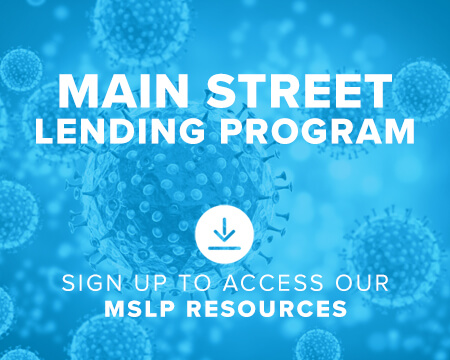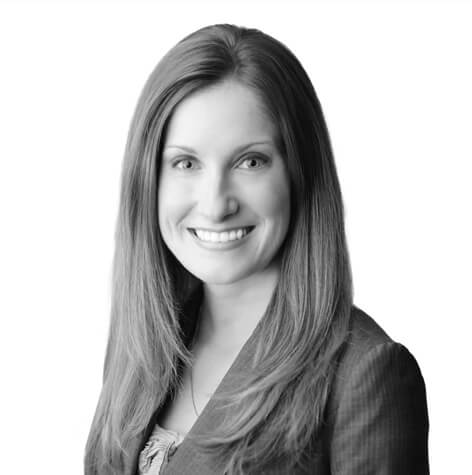UPDATE: On July 28, 2020 the Federal Reserve Board announced an extension through December 31 of its lending facilities that were scheduled to expire on or around September 30, which includes the Main Street Lending Program.
On June 8, 2020, the Federal Reserve further expanded its Main Street Lending Program (Main Street Program) to bolster participation by borrowers and lenders. These changes include:
- Lowering the minimum loan size for certain loans to $250,000 (from $500,000);
- Increasing the maximum loan size for all loan facilities (as described below);
- Increasing the term of each loan facility to five years (from four years);
- Extending the repayment period for all loans by delaying principal payments for two years (rather than one year), with interest-only payments commencing year two; and
- Raising the Federal Reserve’s participation to 95 percent for all loans.

Once operational, the Main Street Program will provide up to $600 billion in liquidity to eligible lenders that make direct loans to eligible, for-profit businesses (generally speaking, U.S. companies with 15,000 employees or fewer, or 2019 annual revenues of $5 billion or less). The Federal Reserve also announced its intention to establish a program for nonprofit organizations. Linked below are copies of the Federal Reserve’s revised Term Sheets and revised set of Frequently Asked Questions (FAQs).
The Main Street Program is comprised of three facilities: the Main Street New Loan Facility (MSNLF), the Main Street Priority Loan Facility (MSPLF), and the Main Street Expanded Loan Facility (MSELF). Loans under the MSNLF and MSPLF are new loans originated after April 24, 2020 by an eligible lender that include the program’s minimum requirements. Loans under the MSELF are upsized tranches, originated after April 24, 2020, of existing loans by an eligible lender that include the program’s minimum requirements.
As revised, all loans will be a five-year term loan with lender risk retention of 5 percent. MSNLF and MSPLF loans now have a minimum of $250,000. MSNLF loans now have a maximum of $35 million (without exceeding four times 2019 adjusted EBITDA), and MSPLF loans now have a maximum of $50 million (without exceeding six times 2019 adjusted EBITDA). Previously, both MSNLF and MSPLF loans were capped at $25 million. The minimum size of an MSELF loan is still $10 million, but the maximum is now $300 million (without exceeding six times 2019 adjusted EBITDA). Previously, the maximum size of an MSELF loan was $200 million (without exceeding either (i) 35 percent of outstanding and undrawn available debt that is pari passu in priority with the underlying loan and equivalent in secured status or (ii) six times 2019 adjusted EBITDA). The 35 percent condition was removed.
Principal payments are now deferred for two years, while interest payments remain deferred for one year (capitalized per the lender’s customary practices). Also, all loans will be amortized as follows: 15 percent due at the end of each of years three and four, with a balloon payment of 70 percent due at the end of year five. Previously, principal payments would have been deferred for only one year, and MSNLF loans would have been amortized in equal, annual installments.
Subject to underwriting, Main Street Program loans can be unsecured. MSELF loans must be secured if the underlying loan is secured, in which case any collateral securing the underlying loan (at the time of upsizing or on any subsequent date) must secure the MSELF loan on a pari passu basis.
Once an eligible lender has been registered for participation, it may begin to process loans for the Main Street Program. However, at this time lender registration has not been opened and the Federal Reserve is in the process of updating previously-released instructions and forms of certain documents for participation (including borrower certifications and covenants). Also, there is no prescribed form of application for these loans, nor does the Federal Reserve intend to publish a list of eligible lenders that have been registered for participation. Potential borrowers should contact their existing lenders to confirm whether they will participate and to discuss the application process.
For assistance and further information, please contact your Varnum attorney.
Additional Information for Potential Borrowers
Per the Federal Reserve’s release of form documentation on May 27, borrowers will be subject to extensive financial reporting during the life of any Main Street Program loan. This will require the calculation and certification of numerous financial data on both a quarterly and annual basis. The financial reporting covenant within a multi-lender facility that is being upsized under the MSELF will be deemed sufficient, however, if it was negotiated in good faith before April 24, 2020. These requirements are set out in Appendix C to the FAQs.
Main Street Program loans also will be subject to mandatory prepayment in the event of a borrower’s material misstatement or knowing breach with respect to certain of the certifications and covenants that are required to be made (including as to executive compensation, stock buyback and dividend restrictions), and will require a cross-acceleration provision triggering an event of default if any other debt of the borrower to the Main Street Program lender or its affiliates is accelerated. Loans under the MSELF that involve a multi-lender facility are subject to additional requirements to the extent feasible under the underlying loan documents given the added complexity of such facilities, and an existing cross-acceleration provision under such a facility will be deemed sufficient if it was negotiated in good faith before April 24, 2020.
Finally, among other things, the FAQs clarify each of the following:
- To satisfy federal regulation applicable to the Federal Reserve’s emergency lending authority, each borrower must certify that it is “unable to secure adequate credit accommodations from other banking institutions.” This does not mean that no credit from other sources is available to the borrower. Rather, the borrower may certify that it is unable to secure “adequate credit accommodations” because the amount, price, or terms of credit available from other sources are inadequate for the borrower’s needs during the pandemic. Also, borrowers are not required to demonstrate that applications for credit had been denied by other lenders or otherwise provide support. However, each borrower must make all certifications in good faith.
- Each loan must include an adjustable rate of interest equal to LIBOR (1 or 3 months) plus 3.0 percent (i.e., lenders do not have discretion in setting the interest rate, regardless of borrower size or risk profile), and lenders are not permitted to charge any fees beyond what is set out in the Term Sheets (except (i) de minimis fees for customary and necessary services to underwrite the loan such as appraisal and legal fees or (ii) customary consent fees if such fees are necessary to amend existing loan documentation in the context of upsizing a loan in connection with the MSELF).
- If an eligible business has an existing loan that requires prepayment of more than “a de minimis amount” upon incurrence of new debt, the business cannot receive a loan under the MSNLF or the MSELF unless such requirement is waived or reduced to a de minimis amount by the relevant creditor (i.e., absent such waiver or reduction, the business would need to be qualified for a loan under the MSPLF, which permits the refinancing of existing debt owed to lenders other than the Main Street Program lender at the time of origination).
- While all of a business’s affiliated entities, domestic and foreign, must be considered when applying the employee and revenue eligibility criteria, only the business’s consolidated subsidiaries (i.e., excluding parent companies and sister affiliates) are considered for determining whether the business has “significant operations in and a majority of its employees based in the United States.” This test is met, for example, if greater than 50 percent of such consolidated business’s assets are located in the U.S., or annual net income is generated in the U.S., or annual net operating revenues are generated in the U.S., or annual consolidated operating expenses (excluding debt service expenses) are generated in the U.S.
- A U.S. business owned by a foreign company can qualify as an eligible borrower; however, the borrower itself must be a qualifying entity that was created or organized in the United States or under the laws of the United States prior to March 13, 2020, with “significant operations in and a majority of its employees based in the United States” (see above for analysis), and proceeds of any Main Street Program loan cannot be used for the benefit of the borrower’s foreign parents, affiliates or subsidiaries.
- If an eligible borrower is the only business in its affiliated group that has sought funding through the Main Street Program, its affiliated group’s debt and EBITDA are not relevant to determining whether that business can qualify, except to the extent that the borrower’s subsidiaries are consolidated into its financial statements. On the other hand, if the eligible borrower has any affiliate that has previously borrowed or has an application pending to borrow under the Main Street Program, then the entire affiliated group’s debt and EBITDA are relevant to determining whether the eligible borrower’s maximum loan size.
- In connection with their obligation to provide certain financial records and to calculate their 2019 adjusted EBITDA, (i) only eligible borrowers that are subject to U.S. GAAP reporting requirements or that already prepare their financials in accordance with U.S. GAAP must submit U.S. GAAP-compliant financial records, (ii) only eligible borrowers that typically prepare audited financial statements must submit audited financial statements (otherwise eligible borrowers should submit reviewed financial statements or financial statements prepared for the purpose of filing tax returns), and (iii) only eligible borrowers that typically prepare financial statements that consolidate the borrower with its subsidiaries (but not its parent companies or sister affiliates) must submit such consolidated financial statements.
Resources
Main Street New Loan Facility (MSNLF) Term Sheet
Main Street Priority Loan Facility (MSPLF) Term Sheet
Main Street Expanded Loan Facility (MSELF) Term Sheet
Main Street Lending Program Frequently Asked Questions (FAQs)
Additional Main Street Lending Program Advisories
Main Street Lending Program: Federal Reserve Announces Revised Terms
Business Law Advisory, April 30, 2020
Main Street Lending Program: Revised Term Sheets Expected Soon
Business Law Advisory, April 29, 2020
COVID-19: Federal Reserve Announces New Loan Facility for Main Street Businesses
Business Law Advisory, April 9, 2020



